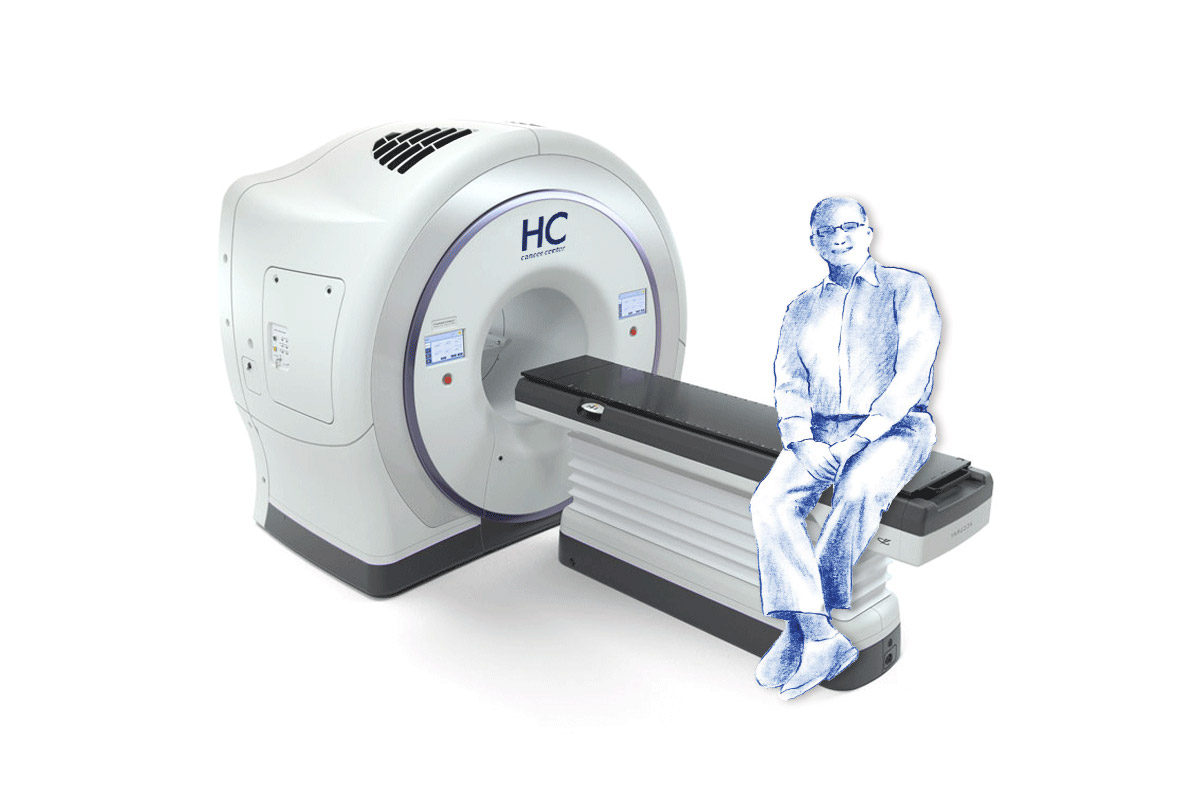Radiotherapy, together with chemotherapy and surgery is a fundamental pillar in the treatment of cancer. Over the years, in addition to medical advances, the development of technology has allowed us to perfect radiotherapy techniques, obtaining more precise and effective and safe treatments.
Currently more than 60% of cancer patients will receive radiation therapy at some point in their treatment.
At HC Marbella we are working to incorporate radiotherapy in our hospital and the city of Marbella in the near future.
 Our center will have an innovative radiotherapy. It is a state-of-the-art tomotherapy, which adapts at all times to the patient and which has a system that tracks the tumor, being the first machine in Europe that incorporates all these functions / qualities.
Our center will have an innovative radiotherapy. It is a state-of-the-art tomotherapy, which adapts at all times to the patient and which has a system that tracks the tumor, being the first machine in Europe that incorporates all these functions / qualities.
Behind this technology, the presence of a great team of professionals is essential. Our recent addition to the team has been Dr. Paula Sedano, a radiotherapy doctor who has worked in reference hospitals such as the General University Hospital Gregorio Marañón in Madrid, expanding her training at the St. Jude Children’s Research Hospital in Memphis (USA).
As a professional in this field, she tells us about the advantages of radiotherapy treatment for cancer patients.
Radiotherapy is a local treatment that is based on the use of ionizing radiation, mainly X-rays, to cause damage to tumor cells and prevent their growth and proliferation. High doses are directed at a specific volume of treatment, minimizing at all times the radiation that reaches healthy tissues near the tumor.
Radiotherapy is part of the multidisciplinary treatment of many tumors. Depending on the moment in which the patient receives the treatment, we can speak of radiotherapy with radical intention (curative) as the only therapy or of adjuvant or neoadjuvant radiotherapy, that is, in combination with surgery and / or systemic treatments (chemotherapy, hormone therapy or other targeted therapies), in order to increase disease control and survival.
In summary, we can say that in a linear accelerator incorporated in the machine, the electrons are accelerated colliding with a target, resulting in high-energy X-rays. These X-rays are directed towards a localized treatment area and produce DNA damage and cell death in tumor cells, thus preventing their reproduction and dissemination.
During this process the patient does not see, does not smell, does not feel radiotherapy, as we often tell them “they have to believe it”. He also does not go home with radiation to the body, so after treatment he may be with children and pregnant women. Generally well tolerated and performed on an outpatient basis. Although it is a treatment that requires several sessions, with new technologies and advances, treatments of shorter duration and equal effectiveness are increasingly carried out.
Radiotherapy is a complex treatment and therefore requires an elaborate prior preparation process. Patients sometimes come to the clinic thinking that they will start treatment that day, but they should know that radiotherapy is not a pill that can be given that same day.
The first step to receive treatment with radiotherapy is to go to the consultation of the doctor specializing in radiotherapy, who performs the medical history, reviews the images and explains the treatment, its benefit and its possible adverse effects. Generally that same day the patient undergoes a simulation CT, that is, a scanner where we replicate the positioning and immobilization conditions with which the patient will then be treated. After this step, our system registers the image of the treatment area to work on it. Both the consultation and the simulation last approximately 1-2 hours and then the patient goes home.
The following days, both the radiotherapy doctor and the radiophysicist are responsible for planning the treatment (delimiting the areas to be treated, calculating the doses that reach the tumor and the doses that reach healthy tissues, etc.). This planning stage can last from a single day (in case urgent treatment is required) up to 10 days in cases of very complex tumors. Once all this is ready, the patient is contacted by phone the day and time that the treatment begins. From that first day of treatment, the patient will have to come to treatment, from Monday to Friday, during the stipulated time.
Radiotherapy is an effective local treatment, not only because up to 60-70% of cancer patients receive radiotherapy, but it also contributes to its cure in up to 40% of cases, a figure that is increasing thanks to new techniques and treatments. In certain tumors such as lung or prostate it achieves results comparable to surgery, without being an invasive treatment. In addition, it allows in selected cases preservation of the organ or function as in laryngeal cancer. It is also a fundamental tool to complement surgical treatment when a complete resection is not achieved, for example.
Like all treatments, it is not without side effects, but these are generally mild-moderate and reversible.
Not all tumors are subsidiaries of radiotherapy treatment since there are locations where toxicity outweighs the benefit or tumors for which surgical or systemic treatment is the best choice.
It is true that for almost all types of tumors there is an indication for radiotherapy treatment, either as the curative treatment of choice, as an alternative to surgery (inoperable patients or those who reject surgery), as a complementary treatment to surgery or systemic therapy. , and even as a palliative therapeutic weapon to control symptoms in more advanced disease.
Radiation therapy in the pediatric patient is a controversial issue, since children are long survivors, and therefore the risk of developing second tumors is more relevant, although it remains low. In addition, those of younger age are still in development and therefore radiotherapy can alter growth or cognitive development, for example, depending on the areas treated. Generally, in children under 3 years of age, attempts are made to not irradiate the central nervous system as much as possible.
However, radiotherapy is necessary in the treatment of many pediatric tumors and today there is no other treatment that achieves the same tumor control rates. The objective, therefore, is to offer more precise radiotherapy to try to damage as little as possible the healthy tissues near the tumor. The proton therapy, is a radiotherapy that treats with heavy particles that present advantages regarding the distribution of the dose, since it allows to reduce the low-moderate doses that the patient receives in the nearby tissues / organs. However, proton therapy has more limited indications and has not yet been shown to be superior to photon radiation therapy in terms of survival. Thanks to the advancement of radiation therapy, pediatric patients can be treated more safely and accurately, without having to rely on a proton therapy center.

The question would be, what won’t you have? This radiotherapy has a tumor tracking system in real time, allowing us to offer maximum precision radiotherapy. This treatment adapts day by day to any physiological movement (such as breathing) and to changes in the patient’s anatomy and tumor size. It is the perfect combination of versatility, precision and safety. As a radiotherapist, it is a privilege to be able to work in a center that pursues innovation and allows me to be part of a new era of radiotherapy.
June 30, 2020
Read other news
Tel.: +34 952 908 628
+34 609 148 799
952908898 Oncology
951829978 Diagnosis by imaging
951829947 Gynecology
952908897 Fertility
951829947 Physiotherapy